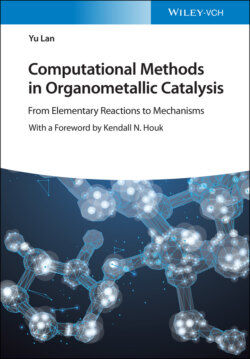Читать книгу Computational Methods in Organometallic Catalysis - Yu Lan - Страница 10
Preface
ОглавлениеA long time ago, when I first came into contact with science, I was fascinated by the unique charm of organic chemistry. The tetravalent carbon atoms and their tetrahedral structures impressed me with elegant simplicity. Through the broken and formation of covalent bonds, various new molecules that possess unique properties could be generated. By manipulating the reaction conditions, catalysts, and ligands in organic reactions, chemists can effectively synthesize plenty of complex natural product molecules and pharmaceutical molecules in high regioselectivity and enantioselectivity. When I was a teenager, I took every organic chemical reaction as a puzzle, and the reaction mechanism is like the answer to the puzzle. In this way, I found great pleasure in thinking about the mechanism of organic reactions. The development of organic chemistry also requires a comprehensive mechanistic understanding. Generally, a significant amount of information about reaction mechanisms could be obtained by experimental techniques. However, the experimental mechanistic study mainly focuses on the macroscopically observed experimental phenomena. Therefore, in many cases, pure experimental observation is not sufficient for revealing the complete reaction pathway and clarifying the origin of selectivity. During my doctoral study at Peking University, I was fortunate to work with my supervisor Professor Yun‐Dong Wu, from whom I learned how to use computational chemistry to investigate the organic reaction mechanisms. Theoretical calculations based on quantum mechanics, especially the density functional theory calculation, have constituted the most powerful tool for mechanistic study due to the development of supercomputer, computational theory, and corresponding software.
In the past several decades, one of the most important advances in organic chemistry has been the introduction of transition metal catalysts to organic synthesis. Transition metal species can react with organic compounds to generate intermediates that contain carbon–metal bonds. Subsequent conversion of these organometallic intermediates could enrich the synthetic approach toward new molecules. Different from organocatalysis, the organometallic catalysis usually goes through multiple steps and complicated catalytic cycles, which originated from the complex bonding pattern of organometallic catalysts and the variation of valance state of the central metal species. Thus, the utilization of theoretical calculation for understanding the reaction mechanism is imperative for the development of organic chemistry. My post‐doctoral research with Professor K. N. Houk was working with experimental chemists to explore the mechanism of organometallic reactions through the collaboration of theoretical calculation with experimental study. The promotion of theoretical study on experimental development could be summarized into “3D,” i.e. description, design, and direction. Based on the data obtained from experimental study, detailed descriptions of the organometallic reaction mechanisms could be fulfilled using theoretical calculation. The mechanistic study then provides further theoretical guidance for the rational design of new reactions, which points out the direction of experimental development.
Over recent decades, massive experimental and theoretical investigations on organometallic catalysis have been reported. In those works, theoretical studies have been proved to be an indispensable technique for modern organic chemistry. Consequently, this book is written to summarize and generalize the theoretical advances in the mechanistic study of organometallic catalysis. This book comprises two parts, which are the general overview of organometallic catalysis and the computational studies of reaction mechanisms classified by transition metals. I hope this book could inspire the mechanistic studies of complex reactions for theoretical chemists, and enable a better understanding of reaction mechanisms for experimental chemists.
29 July 2020
Yu LanZhengzhou, P. R. China
